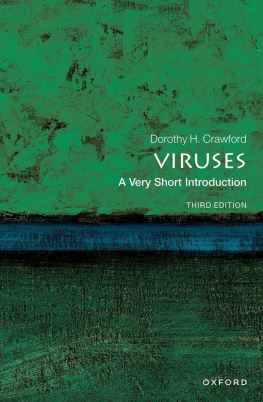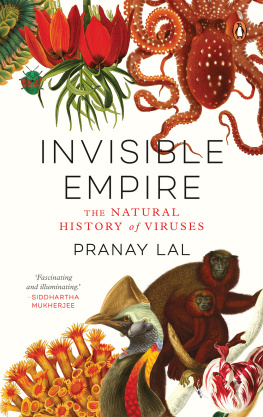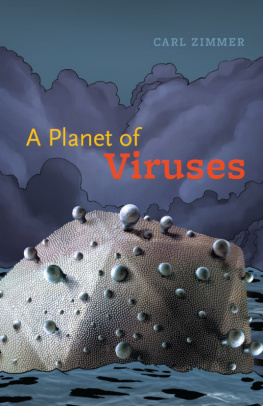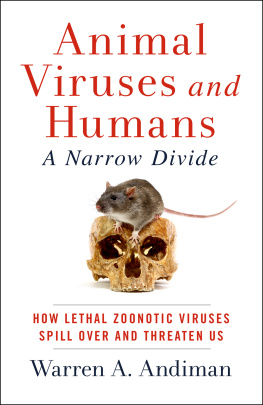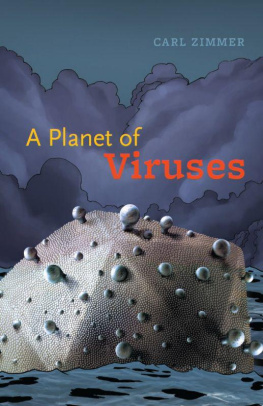VirusesThe Invisible Enemy
Dorothy H. Crawford is Emeritus Professor of Medical Microbiology at the University of Edinburgh. She has authored numerous scientific publications, and is the author of several popular science books including Deadly Companions: How Microbes Shaped our History (OUP, 2007, second edition 2018), Viruses: A Very Short Introduction (OUP, 2011, second edition 2018), Virus Hunt: The Search for the Origin of HIV (OUP, 2011), Cancer Virus: The Story of Epstein-Barr Virus (OUP, 2014), and Ebola: Profile of a Killer Virus (OUP, 2016). She is a Fellow of the Royal Society of Edinburgh, a Fellow of the Academy of Medical Sciences, and was awarded an OBE in 2005 for services to medicine and higher education.

Great Clarendon Street, Oxford, ox 2 6 dp , United Kingdom
Oxford University Press is a department of the University of Oxford. It furthers the Universitys objective of excellence in research, scholarship, and education by publishing worldwide. Oxford is a registered trade mark of Oxford University Press in the UK and in certain other countries
Dorothy H. Crawford 2021
The moral rights of the author have been asserted
First published 2000
First published in paperback 2002
Reprinted 2009
Second edition, as Oxford Landmark Science, published 2021
Impression: 1
All rights reserved. No part of this publication may be reproduced, stored in a retrieval system, or transmitted, in any form or by any means, without the prior permission in writing of Oxford University Press, or as expressly permitted by law, by licence or under terms agreed with the appropriate reprographics rights organization. Enquiries concerning reproduction outside the scope of the above should be sent to the Rights Department, Oxford University Press, at the address above
You must not circulate this work in any other form and you must impose this same condition on any acquirer
Published in the United States of America by Oxford University Press
198 Madison Avenue, New York, NY 10016, United States of America
British Library Cataloguing in Publication Data
Data available
Library of Congress Control Number: 2021943061
ISBN 9780192845030
ebook ISBN 9780192659521
Printed in Italy by L.E.G.O. S.p.A. Lavis (TN)
Links to third party websites are provided by Oxford in good faith and for information only. Oxford disclaims any responsibility for the materials contained in any third party website referenced in this work.
This book is dedicated to
William, Danny, and Theo, and my extended family
Viruses: Foreword
When modern science began to take shape in Europe in the seventeenth century, and even as it developed in the eighteenth, the concept of a professional scientist was unknown. Those who actively investigated scientific matters, as well as those who were merely interested, were largely well-educated members of the upper classes. Indeed, this situation continued well into the nineteenth century, as evidenced by elections to the Royal Society of London, the UKs national academy of science and the longest-established scientific society in the world. During those centuries it was thus usual for well-informed people to be able to understand most of the science, or natural knowledge as it was then called, which was being discovered and discussed at the time.
However, the latter half of the nineteenth century saw advances in science accelerate and the birth of whole new areas of research with their attendant academic disciplines; as a result, the pursuit of science became a career instead of a hobby. The past few decades have witnessed a veritable explosion in knowledge, with hundreds of new subjects of ever-greater complexity, huge and costly research undertakings, and a vast worldwide army of highly specialized scientists. The ordinary citizen, however generally well educated, has long been left behind in this unimaginably complicated era of new ideasconfusing, impenetrable, and unintelligible, except to experts.
This would not perhaps matter greatly were it not that the technological results of scientific progress impinge more and more on the way society functions and, even more important, on the way the individuals who make up society live their own lives. There now exist acute anxieties over what people perceive as the arcane and threatening progress of science, examples being the genetic manipulation of food and human reproduction, the polluting effects of technological advances on the environment, and the influence on behaviour of a globally penetrating mass media.
An obvious consequence of the publics bafflement over science is to be seen in the present anti-science backlash evident in Western countries, which is not only directed against science and scientists but also against the multinational companies employing the new technologies which advances in science have provided. It is regrettable that scientists have, on the whole, been reluctant to come forward and explain the nature of whatever highly specialized work they may be doing, and have likewise hesitated, particularly in the face of sustained tabloid hysteria, to stand up and make clear the huge benefits to mankind of recent scientific progress.
But without an understanding of what science is about and how it works, the public is not in a position to evaluate findings, make judgements about their impact on daily life, or appreciate the nature of risk or scientific uncertainty. It is therefore to be greatly welcomed that Professor Dorothy Crawford has now set out in this book a laymans straightforward and authoritative guide to virology, a subject constantly affecting our daily lives in both trivial and life-threatening ways. The extent of confusion and misinformation in this area is exemplified by the continuing inability of even the serious press to distinguish the fundamental differences between viruses and bacteria. Professor Crawfords reliable and readily comprehensible account of the viruses of man is thus more than timely, and clearly explains, in an engaging way, a field of science which is too often garbled by the uninformed. Her book will fascinate the curious public and should be obligatory reading for all those journalists who so regularly display their ignorance of this important subject.
Sir Anthony Epstein 2000
Professor Crawfords excellent review of the topic of virology should be obligatory reading for all those mystified by the COVID pandemic. The updated new edition contains a timely explanation of this novel, animal-derived virus disease which is so affecting all our lives.
Sir Anthony Epstein
Oxford, September 2020
Preface
December 2019the month that changed our lives. COVID-19 arrived and suddenly no more hugs, kisses, or handshakes. No parties, meetings, or holidays. Schools, universities, restaurants, and hotelsall closed. Health services overwhelmed, COVID sufferers dying alone, and loved ones denied attendance at their funerals.
These are the conditions under which I am writing now, but when I wrote the first edition of The Invisible Enemy in 19992000, the HIV/AIDS pandemic was at its height. Scary, inflammatory, and frankly fictitious stories about HIV/AIDS appeared in the media, fuelling prejudices and engendering panic. Labelling the outbreak the gay plague, press reports encouraged discrimination with headlines like Place AIDS victims in quarantine, Blood on their hands, and even Exterminate gays.


